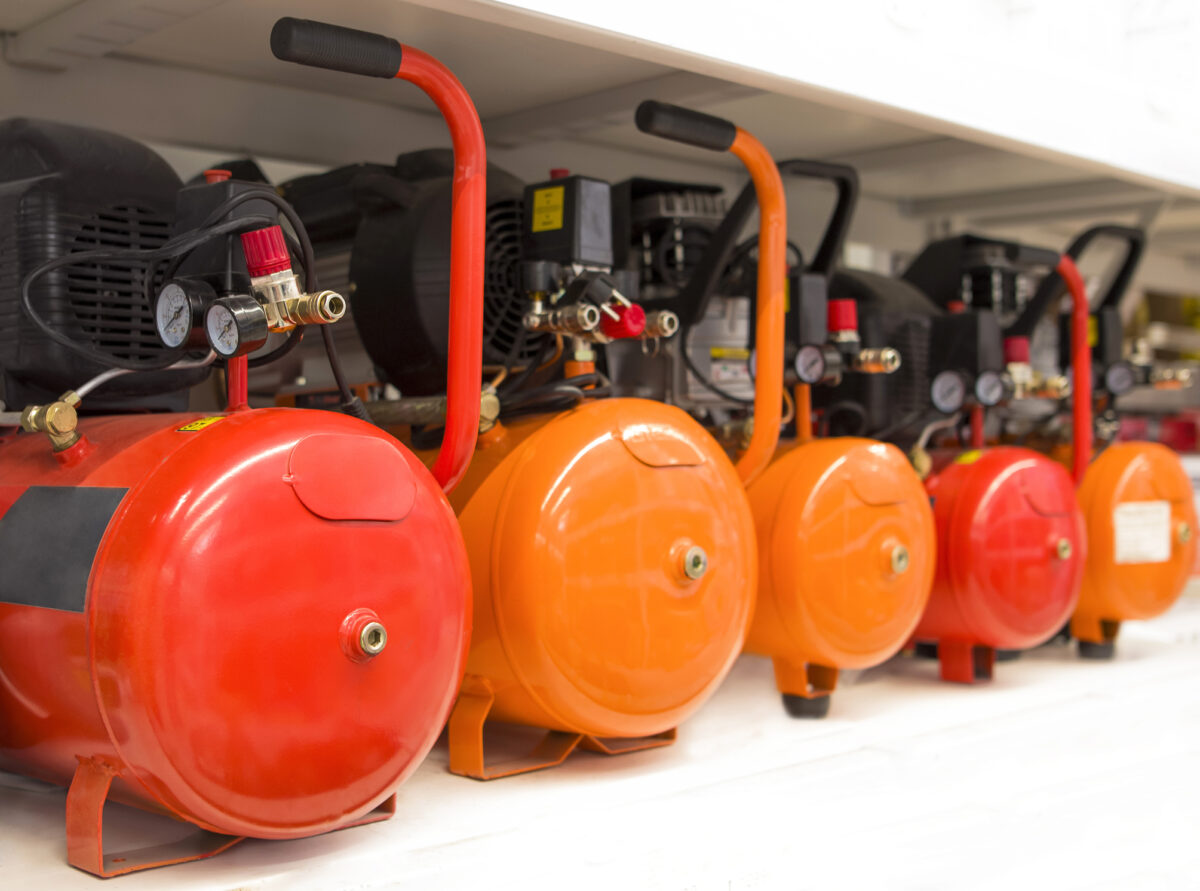Jump To:
How to Increase CFM on an Air Compressor
Looking to boost the CFM of your compressed air system? Unfortunately, it’s important to note that you cannot exceed the CFM rating of your compressor, but if your air compressor is not reaching the intended CFM that it is rated for or you are aiming for better performance, there are a few simple things to optimize your system’s efficiency like choosing a larger compressor, using larger tanks, add a second compressor and choosing a suppressor with a higher pressure. But first, what is CFM?
What is CFM?
CFM, which stands for Cubic Feet per Minute, is the amount of airflow you’ll get under the specific conditions of your location. It measures how much air your compressor can draw in per minute, taking into account factors like temperature and pressure. So, if your compressor has a rating of 100 CFM, it means it can generate 100 cubic feet of compressed air every minute. This measurement plays a significant role in telling you how efficiently an air compressor functions, essentially dictating the amount of air that a compressor can supply.
However, when we talk about CFM in the context of an air compressor, it’s not a stand-alone measurement, and we’re referring to the volume of air that the compressor can produce at a given PSI (pounds per square inch). For example, your air compressor would be rated for 100 CFM at 100 PSI, not just a certain CFM. It’s essentially the power output of your compressor, or in simpler terms, the breath of your air compressor. A higher CFM essentially means that your air compressor is capable of supplying more air and is often more powerful.
The interaction between pressure and CFM varies based on the type of compressor you’re using.
For a Variable Speed Drive (VSD) compressor, CFM and pressure (PSI) have an inverse relationship. If you increase the pressure, the CFM decreases, and vice versa: lowering the pressure increases the CFM.
In contrast, Fixed-Speed compressors produce a constant airflow regardless of use. Altering the CFM is not possible without adding more horsepower (HP) Reducing CFM isn’t an option either because using less air means the compressor will be in an unloaded state more often than not. However, changing the pressure affects the energy required to maintain that pressure. A higher pressure means more energy consumption as the compressor works harder to maintain air production and vice versa.
Increasing CFM on an Air Compressor
When it comes to finding means of increasing the CFM on an air compressor, several factors come into play.
Selecting The Right Compressor
Choosing the right compressor based on your CFM requirement is fundamental to meeting your air needs. Always check the CFM requirement of the tools you intend to use and make sure your air compressor meets or exceeds that requirement for best performance.
Opting for A Bigger Compressor
This option might sound obvious, but a bigger compressor can indeed deliver a higher CFM than a small compressor. This is due to their larger pump and motor sizes, which allow them to compress more air per revolution, thereby providing a higher CFM. However, ensure that the larger compressor has the same duty cycle, or you may only be able to run the compressor at half load.
Choosing A Compressor with Higher Pressure
Air compressors with a high maximum PSI allow the compressor to fill the tank with more airflow, thus enabling higher CFM. However, remember that the output pressure will not exceed the maximum pressure switch setting.
Use of A Larger Tank or Add an Extra Tank
A larger tank size or extra tank will store more air, allowing your compressor to rest between fill cycles – hence extending the duty cycle. This will keep you from having to try to increase the CFM of your whole system to meet your peak demand. This can vastly increase the efficiency of your system as you can draw on this air supply and get by with a lower overall CFM.
Adding A Second Compressor
Adding a second compressor can actually increase your total CFM. This can be useful during busy times when you need more air, as it splits the workload between the two compressors.
Before deciding on any course of action, evaluate the cost-effectiveness and long-term sustainability of your decisions. Remember, when increasing the CFM on your air compressor, it’s critical to understand your CFM needs, compressor capabilities, and the options available to you.
Practical Tips to Maintain Maximum CFM
Establishing optimum CFM on your air compressor is only one part of increasing CFM. The other equally important factor is maintaining and creating an environment where your compressor can perform at its best. Here are some practical tips to maintain maximum CFM for your air compressor.
Maintain Your Compressor
Regular maintenance goes a long way in ensuring your air compressor’s performance and longevity. Keep your compressor clean and check for and repair any air leaks as they can significantly decrease your compressor’s CFM.
Correct Usage of Pneumatic Tools
Try not to use more than one high CFM tool at a time if you can help it. Overloading your air system can reduce the CFM and put a strain on your compressor.
Preventing Pressure Drop
Pressure drop in any air system is an enemy of efficiency and can affect the delivered CFM adversely. Keep your pipe runs as short as possible and ensure the size of the pipes is correctly matched to the CFM and PSI output.
Maintaining Output Pressure
Make sure that your air pressure at the tool end is sufficient. The air pressure drops as the hose or pipe gets longer, so do take the required measures to compensate for the pressure drop.
Managing the Duty Cycle
Make sure not to exceed the air compressor’s duty cycle, which is the amount of time a compressor provides consistent pressure (PSI) and flow (CFM). Operating the compressor continuously, exceeding its duty cycle, can result in overheating and a consequential drop in CFM.
Air Compressor Modifications to Get More CFM
Want more CFM from your current air compressor without reducing your facility’s PSI? It’s doable, but it involves substantial changes. Simply tweaking settings won’t push the CFM beyond what your compressor is designed to handle. To achieve a higher CFM, you need to enhance both the compressor pump and motor, essentially requiring you to add more horsepower into the system. This kind of upgrade, especially for large industrial compressors, is essentially rebuilding the compressor for a higher CFM capability, which can be costly.
In many instances, it’s better to invest in a new, bigger compressor (like a Variable Speed Drive or VSD model) or to supplement your system with an additional compressor. If your current setup doesn’t suffice your specific needs in terms of CFM capabilities, selling it and using the proceeds towards a more capable unit might be a smart move.
How Advanced Air & Vacuum Can Help
Navigating the best ways to increase your air compressor CFM is no easy task, but luckily for you, our team at Advanced Air & Vacuum is ready to assist!
We have years of experience and a deep understanding of the vast world of air compressors and pumps. We deal with nearly all recognized air compressor and vacuum pump manufacturers, negating the need for you to face the hassle of doing it yourself. Our air compressors and services, teamed with our expertise, make us the one-stop solution for all your compressor, vacuum, pump, electric motor, and air compressor piping needs. We specialize in the installation of new compressors and the repair and maintenance of broken compressors ensuring that your air compressor runs as it should. For detailed queries or professional assistance, contact our team of experts for all of your air compressor needs.

